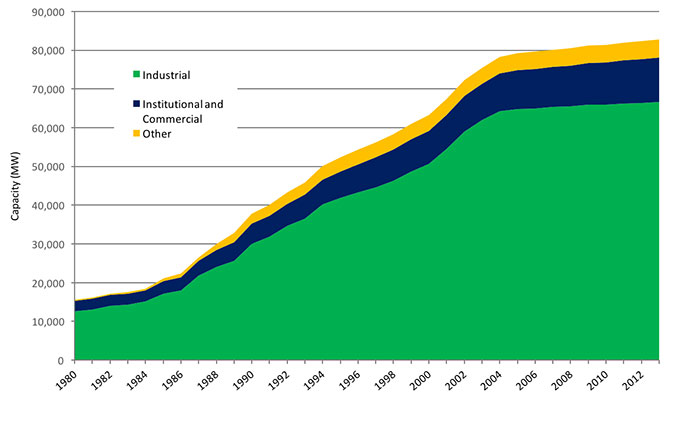Combined heat and power (CHP) systems, also known as cogeneration, generate electricity and useful thermal energy in a single, integrated system. Heat that is normally wasted in conventional power generation is recovered as useful energy, which avoids the losses that would otherwise occur from separate generation of heat and power. While the conventional method of producing usable heat and power separately has a typical combined efficiency of 45 percent, CHP systems can operate at efficiencies of 60–80 percent or more.
The CHP concept was first applied in 1882 at Thomas Edison’s Pearl Street Station, the first central power plant in the United States. The plant provided electricity and steam to a section of downtown New York. But, as the electric era emerged in the 20th century, and power plants moved away from cities to rural areas, uses for the excess heat became limited and CHP fell out of favor.
The passage of the Public Utility Regulatory Policies Act of 1978 (PURPA) ushered in the modern CHP era. This law included a provision that legalized the sale of non-utility-generated electricity to the grid, which helped increase the use of CHP. While some large industrial facilities generated electricity prior to PURPA, its passage more than doubled CHP capacity by the early 1990s (see figure). The prospects for CHP were further advanced by provisions in the Energy Policy Act of 1992 and the combined effects of both policies resulted in a quadrupling of CHP capacity by the early 2000s.
CHP capacity in the United States by sector
Source: ACEEE analysis from ICF data
The uncertainty created by natural gas price volatility beginning in the early 2000s, combined with the recessions of 2001 and 2007–2009, largely stalled additions to CHP capacity in the industrial sector. Despite these factors, CHP capacity in the institutional and commercial sector continued to grow during this time period. This is likely due in part to the financing capabilities of institutional entities, like universities and hospitals. Institutions often accept longer investment horizons than the business sector, helping maintain a steady increase in new CHP capacity in the sector.
With the economic recovery and relatively low natural gas prices, we have seen interest in CHP returning, particularly where the added benefit of electric reliability is valued. Another trend expected to encourage CHP in future years is increased demand for emissions reductions, especially with EPA’s Clean Power Plan and the commitment to reduce greenhouse gases under the Paris agreement.
For more on national energy metrics, see Energy Efficiency in the United States: 35 Years and Counting.
Data Points is a blog series focusing on the graphs and other images that tell the energy efficiency story.


